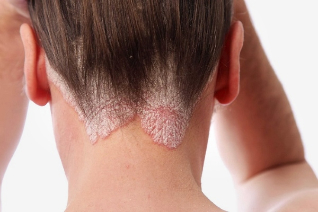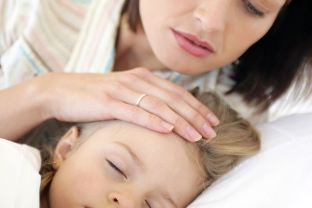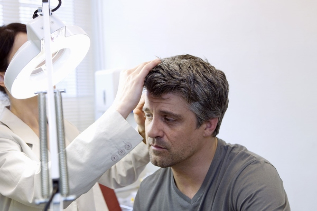Psoriasis is a skin non-communicable disease, which occurs in 1 out of 100 persons, while in 80% of cases detected by slaughter the hair of the head. It manifests itself in the form of education red plaques or spots, between which is seen intact skin. Inflammation may extend and connect between each other. Why appear psoriasis and how to treat it, we'll find out on.
Brief help on the pathology

Psoriasis on the head - it is an autoimmune disease. Such conclusion of the doctors was made after in the course of research in the plaques are defined by the characteristic of an autoimmune disease changes and therapy stunning immunity to the drugs has allowed greatly facilitate the overall condition. This disease is not transmitted from a sick to a healthy person.
Psoriasis can affect anyone, however, clinical experience allows to allocate the basic group of risk. So, the more frequent pathology affects women, and genetically inherited form makes itself known in 15-25 years. Sick more than in 50% of cases have relatives with psoriasis this or that form. This means that the risk of meet with a similar pathology more high for those whose parents, brothers or sisters also have this diagnosis. Psoriasis of the scalp, as usual, can affect the following areas:
- parting;
- the upper part of the forehead;
- the area behind the ears;
- whiskey;
- on the back side of the head;
- the skin on the ears, including the ears;
- doug's eyebrows.
As usual, such a psoriasis has a wavy character of the flow, i.e. it is assumed with alternating periods of improvement and the stage of exacerbation. The affected areas appear red teardrop plaques with sebaceous content that regularly bark and cause itching. This inflammatory process leads to serious consequences for health, but becomes a cause of serious psychological problems. Very often a vicious circle arises when psoriasis causes stress, and this, in turn, becomes the cause of complications the incidence of pathology.
The disease itself does not cause hair loss, but to temporary alopecia may cause some methods and therapy, stress or damage to the skin. Usually, the hair grow back after skin cleansing and stabilization of the emotional state.
Why is it established?

Doctors have not yet revealed the exact causes that cause inflammatory reactions and excessive synthesis of skin cells on the body of the patient. At this point the main hypothesis is genetic. She says that individual people have a congenital predisposition to the speedy update of the keratinocytes (the main cells of the epidermis a person's skin). In the manifestation of psoriasis such dependence causes a specific reaction in the immune system:
- The body begins to rapidly produce new cells, forming a psoriatic plaque.
- Will become more active inflammation of the skin in the affected area (the body sees it as something foreign).
- The stronger the hurt, the skin under the influence of immunity, by actively occurs in dividing keratinocytes.
A long time genetic factors may be in a latent state, but he wakes up under the influence of unfavorable factors. These include:
- Stress. Changes in the nervous system are the cause of disorders in the work of all organs, including the skin. In the end, it leads to changes in the division of epithelial cells.
- Frequent skin injuries. Provoke the failure in the process of division and growth of keratinocytes.
- Infectious diseases. The bacteria attacks the human immune system, and in particular in the case that the disease is a chronic form. In the result of immunity is constantly in tension and begins to attack the epithelial cells.
- Dryness and skin sensitivity. In this case the skin of the veil often suffer microtraumas, and therefore there is a high probability of occurrence of psoriasis.
- Climatic conditions. When dry and cold air of the skin is exposed to greater exertion, and, therefore, its violation, which will lead to psoriasis.
- Diseases of the endocrine system. They become the cause of the failure of the production of melatonin and trigger increased secretion of growth hormone.
Another popular hypothesis states that psoriasis develops due to violations of metabolism. In this case your body specifically responds to stimuli, begins to rapidly divide the cells of the dermis. If normal skin regenerates in the course of 3 weeks, then for patients it will happen in 5 days, thus making the head appear numerous plaques. In this case, cause the deterioration of these factors:
- injury of the scalp;
- the emotional strain and stress;
- a violation of hormonal background;
- disorders of the endocrine system;
- bad habits (smoking, abuse of alcoholic beverages);
- infectious processes in the body;
- improper nutrition;
- intake of certain drugs;
- hypothermia or long-term exposure to the cold;
- non-standard use of funds for the care of the scalp.
In some cases, the initial point of development of psoriasis can become a pathology of the immune system, which can arise due to severe stress or suffering from an infectious disease.
It turned out that HIV-infected people get sick of psoriasis in raze 3 more often than healthy people.
As the pathology is manifested?
Psoriasis develops gradually, whereby it can be identified at different stages of the following processes:
- On the surface of the skin will appear pink rash, which have a rounded shape and the top are covered with numerous plates of white color.
- The rash gradually grow and increase in diameter. Eventually turns into a sealed psoriatic plaque, which cause itching and burning. Then it starts with a strong inflammatory process.
- Fabric too grow under the pressure of excessive reproduction of ectodermal cells in the plaques, and excessive accumulation of lymphocytes and macrophages. This leads to a thickening of the skin in places of damage and the formation of red spots in the field of hair growth.
- The patient is experiencing a general malaise and weakness. He may jump to much higher numbers the temperature of the body.
- The skin becomes more sensitive, painful and more dense. Gradually it loses its elasticity and suppleness, becomes more rough and covered with boards, which will quickly peel.
- When brushing the skin of the head is covered with bleeding scrapes and cracks.
- Food stamps gradually the crust, so in the hair you can see a huge seam, resembling dandruff.
- The itching becomes more intense, and even gives a person to engage in the usual chores.
- A person is depressed, or constantly gives the feeling of great aesthetic discomfort.
- Pathology is spread throughout the scalp and other areas of the body.
In order to maximize reduce the manifestations of psoriasis, it is necessary at the first cutaneous eruption on the head to consult with a dermatologist, pass the examination and start the treatment.
Function symptoms in children

Psoriasis of the scalp in a child develops virtually the same, as in adults, but more often the disease makes itself known by these signs:
- redness of the scalp, which is visible even through the hair;
- wet softening of the skin, that in medicine is called maceration;
- desquamation of the plaques;
- education the buildup of plaque on individual sections of the scalp.
In children of the younger age group psoriasis often resembles the education of diaper rash. The disease develops very slowly and difficult to treat.
Classification pathology
Psoriasis scalp is classified according to two parameters - the shape and stage of development. It is from them depends how it looks disease. Each parameter is examined separately.
Form
On the form of psoriasis is of two types:
- Light. Basically, it manifests itself on the head in the form of individual stand defeat. As usual, the plaques have a small size and is applicable to thin plates.
- Heavy. Psoriatic elements appear on the entire scalp. According to the size of the plaque and more, and a thickness, than in the mild severity of the pathology.
Phase
Experts identify three phases of the disease:
- Continues. On the scalp appear new difficulties. They are usually affects the area on the curve of growth of hair. For psoriatic elements appear flaking. Gradually the islets of acne can associate, forming large zone of the lesion. If the phase occurs at the time of relapse of the disease, then it is already available elements, is spread on the periphery of what is referred to as the phenomenon of Kebner.
- Inpatient. The inflammatory process is maintained, however new difficulties. For this stage is typical of the moderation in the growth of plaques and the lack of a hyperemic rim around the perimeter of the skin elements.
- Regressive. Decreases the volume of the rash, which shows the effectiveness of the conducted therapy. Gradually disappearing available plaques, which changes the pigment spots. The patient more, I don't mind the flaking, itching, and other symptoms of pathology.
Diagnosis

If there is a rash on the skin of the head, it is necessary to turn to a dermatologist. Moreover, it can be performed a consultation with an expert in the treatment of hair (officia) and with the beautician, who will help you choose shampoos and other means for care. In the diagnosis of the disease plays a significant role for the identification of psoriatic triad, consisting of such phenomena as:
- Stearic spots. Amplified flaking, and plaques having a silvery color and resemble stearin.
- Psoriatic foil. If you remove the plaque, in their place appear moist, shiny surface.
- Blood rosa. When brushing plaques appear kap point of bleeding.
These symptoms allow the diagnosis already during the visual inspection. In this the doctor takes into account the data history, including specifying whether there is at the patient's relatives who suffer from psoriasis. To confirm the diagnosis, your doctor may prescribe a biopsy (sampling of material from infected fields) and the sowing of plants to avoid fungal lesions. In the case of generalized forms of psoriasis in addition is solved by the general analysis of blood. When the intoxication of the organism and it will manifest a high rate of red blood cell sedimentation rate (ESR) and increased number of leukocytes.
Joint therapy
Psoriasis of the scalp requires an individual treatment that will help remove the unpleasant symptoms, and what is most important - to achieve long-lasting remission in any form of pathology. For these reasons, it is often appointed complex therapy. Each component deserves special attention.
It is aimed at the fight against chronic inflammatory reactions and excessive formation de keratocytes, because it's the pathological processes that underlie disease. In the context of the overall treatment the doctor may prescribe the following medications:
- means of non-specific immunotherapy (Pirogenala, ATP);
- vitamin complexes;
- immunomodulators;
- aromatic retinoids (Etretinate, Acitretin);
- cytostatics;
- corticosteroids;
- solution Gemodeza intravenous drip introduction.
Receiving cytostatics and corticosteroids suitable in case of severe occurrence of psoriasis and with considerable severity of the symptoms on the scalp. If psoriasis also complicates the onset of infection during treatment with injected antibiotics.
In the context of the overall treatment, your doctor may also prescribe antidepressants. They need to reduce and eliminate related psoriasis emotional problems - depression, stress, increased anxiety and socialis phobia. In addition, these products will improve the stability of the patient to stress, reduce the frequency and severity of exacerbations of psoriasis on the background of nervous tension, improve sleep quality. Some drugs have antihistamine action, so also help to remove itching.























